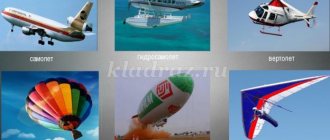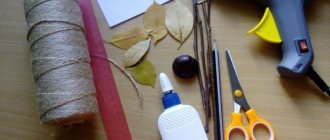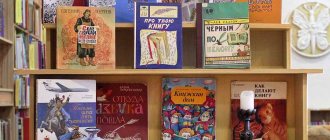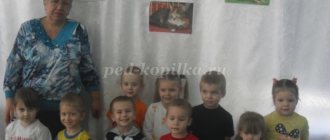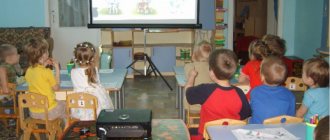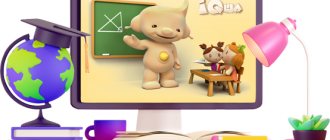Summary of a lesson on cognitive development in the preparatory school group “Red Book”
Summary of a lesson on cognitive development in the preparatory school group “Red Book”
Educational field: Cognitive development
Type of GCD: introduction to the natural world.
Goal: To consolidate the belief about the pricelessness of nature and bring to the conclusion about the need to protect birds.
Tasks:
Educational: to cultivate a sense of responsibility for one’s behavior in the natural world, the skills of caring for animals and plants; evoke an emotional response. Cultivate kindness, responsiveness, and love of nature.
Developmental: instill feelings of empathy for the problems of the surrounding nature; encourage them to be active conservationists; develop an understanding of the importance of the role of animals and plants in human life, develop logical thinking, attention, observation, curiosity; increase children's speech activity, mental activity, and develop the ability to answer questions.
Educational:
Teach rules of behavior in nature; understand the connections that exist in nature, clarify the role of humans in the life of birds; list protected birds listed in the Red Book; enrichment and activation of vocabulary on the topic.
Equipment: multimedia projector, containers for oil and water, fur, brushes, napkin, oilcloth, gel ball, needle, flower.
Progress of direct educational activities.
1. Organizational moment. (in a circle)
All the children gathered in a circle.
I am your friend and you are my friend.
Let's hold hands tightly
And let's smile at each other.
Educator: - I’ll look at your faces, who should I make friends with here?
Educator: Today we will go on an exciting journey into the mysterious world of nature, learn about the existence of an unusual book and what it is needed for.
Please look at the screen. What is this? (children's answers).
-That's right, the Red Book. Who knows what kind of book this is? (children's answers)
— Among the birds, animals, insects, trees and flowers, there are some of which there are very few left. They are called rare or endangered. Why do you think they have become rare? (children's answers)
— Rare animals and plants in our country and in our district are protected by law. But unkind people often break this law. Man is often very cruel to plants and animals. Very often people do not spare them and destroy them for their own purposes. Some suffer because of beautiful fur, others because of tasty meat, and others because people are afraid of them. Gradually, there are fewer and fewer plants and animals left. And then people started thinking about how to stop the disappearance of animals. So we decided to create a Red Book. Why Red and not some other color?
Abstract of the GCD “Acquaintance with the Red Book” in the preparatory group
Abstract of the educational activity “Acquaintance with the Red Book” in the preparatory group
Author : Elena Borisovna Korchemkina, teacher of the MDOU Kondratovsky general developmental kindergarten No. 2, Perm region, Kondratovo village. Description of the material : I offer you a lesson summary for children 6-7 years old. This is a summary of educational activities aimed at developing in children a desire to take care of the environment and protect it. This summary will be of interest to teachers of senior and preparatory groups, primary school teachers, and parents. Goal : introducing children to the Red Book and its representatives. Objectives : - To consolidate children’s knowledge about the habitat of animals, birds, and plants listed in the Red Book. — To form generalized ideas in children that humans need to protect the animal and plant world. — To instill in children a caring attitude towards all life on Earth. — Explain the need to create a Red Book. Preliminary work : holding conversations about the life of animals, reading fiction about nature, learning poems. Equipment : Red Book for children, illustrations of animals and plants, you can use a projector and watch it as slides. Progress of activities The teacher draws the children’s attention to the Red Book that appears in the book corner.
Educator: Who do you think this book is about? Children: This book is about animals. Educator: Why do you think this book is about animals? Children: This book is about animals because there are animals on the cover. Educator: Why do you think the cover of this book is red? Children: Because red is a beautiful, bright, elegant color. Educator: What else can the color red mean? Children: The color red can mean attention, prohibition, danger, warning... Educator: This book is red because it contains animals, birds and plants, of which there are very few left on earth. Hunting of these animals and birds is prohibited, and rare plants cannot be collected. This book is called Red. The teacher opens the Red Book and shows it to the children. Educator: Let's open this book. Look, have you seen these animals, birds, plants?
Children: No. Educator: These animals, birds became extinct, plants disappeared, because before there was no such Red Book. People did not know that there were very few of them left and they needed protection. What do you think will happen to other animals, birds and plants if we don't protect them? Children: Plants will disappear, there will be no animals in the forests, birds will not sing, beautiful plants will not bloom. Educator: Let's get acquainted with those animals, birds and plants that are listed in the Red Book and that need our protection. Educator: Did you like our journey through the pages of the Red Book? Children: Yes. Educator: Why is this book called Red? Children: This book is called Red because it contains animals, birds and plants, of which there are very few left, they need to be protected and treated with care. Educator: What animals, birds and plants do you remember? Why? Children: Beavers, polar bear, woodpecker, lily of the valley... Educator: Why do you think the natural world needs our protection? Children: Animals, birds and plants are defenseless against humans. If we fail to take care of nature, all life on Earth will suffer. Educator: How would you like to help animals, birds and plants when you become adults? Children: I will grow up to become a scientist and help preserve nature. And I will work at the zoo, I will breed new animals. And I want to be a forester and protect the forest from poachers! Educator: Today you got acquainted with an interesting and important book. Now it will always be in our book corner. You tell your parents about it. I propose to draw animals, birds and plants and create a Red Book of the Perm Territory. Together we will try to take care of everything that surrounds us. And here are the pictures the guys drew after the lesson.
We recommend watching:
Summary of GCD for children of the preparatory group. How good it is to be able to count GCD in economics for children of the preparatory group GCD for traffic rules in the preparatory group. Traffic Light School Open GCD in the preparatory group
Similar articles:
Summary of a thematic music lesson for children 6-7 years old
Summary of GCD in the preparatory group on the topic: Kindergarten
Lesson notes for the preparatory group. Cultured man
Summary of a lesson on labor education in the preparatory group. Inventions and achievements of man
Summary of a lesson on the topic “Pedigree” in the preparatory group
Summary of a lesson in the preparatory group on the topic “The Red Book”
Summary of a lesson in the preparatory group on the topic: “The Red Book”
Goal: — to introduce children to the Red Book;
— to form children’s cognitive, creative interests in the environment;
- fostering an emotionally positive attitude towards the nature of the native land.
Tasks:
1. Identify the significance of the “Red Book” and why it was created.
. Cultivate a love for nature.
Progress of the lesson
- What animals do you know that do not live on Earth now? (Dinosaurs, mammoths). Why did they become extinct? (slide 1,2)
— Mammoths lived a very, very long time ago, when the Ice Age came, it became very cold. Many animals were unable to provide themselves with food and were freezing. And soon many animals became extinct. And we know very little about their existence. But even now some animals are disappearing. For what reason do you think?
- Listen to the story. Reading the story "Sea Cows".
Many years ago, a Russian ship was wrecked near distant, unknown islands in the Pacific Ocean. The sailors escaped, but they were in danger of starving to death. And then they saw that huge sea animals, similar to large whales, were swimming off the coast in whole flocks. They were peaceful and so trusting that they allowed themselves to be touched. They ate algae, and the sailors called them sea cows. Sea cow meat
It turned out to be tender and tasty, so the sailors did not die of hunger. They were able to build a small boat from the wreckage of the broken ship and sail home.
Having heard about the amazing animals, other people began to sail to these islands and stock up on meat. But no one thought that the sea cows needed to be protected, and in less than 30 years they were all killed. Scientists have long hoped that there were sea cows somewhere else; they looked for them, but never found them. There is not a single sea cow left on Earth.
Discussion to consolidate what was heard:
— What amazing animals did the sailors meet?
- How do you imagine sea cows? (slide 3.4)
More than a hundred species of different animals and birds were destroyed by people. Some were hunted too hard, others were not left even a piece of land (forest or steppe) where they could live, and others were caught by predators brought by people. Many plants have also disappeared. In the end, people realized: if nature is not helped, more and more plants and animals will die. To prevent this from happening, we compiled a Red Book (slide 5).
Why do you think the Red Book was called Red, and not green or blue? Presentation about the Red Book (multimedia).
The Red Book is not an ordinary book. Red color is a signal of alarm, impending danger, warning. The pages of the book under the red binding have different colors - red, white, yellow, green.
Red leaves are plants and animals of which there are very few left on Earth and are in danger of extinction.
Whiteleafs are a rare and endangered species, but are found only in small numbers and in such a limited area that they could easily become extinct.
Yellow leaves are plants and animals, the number of which is constantly decreasing, but is still sufficient for survival if their living conditions do not deteriorate sharply.
Green leaves are plants and animals that are restored thanks to human care.
At the end of the Red Book there is a brief description of where rare plants and animals live and how many of them remain.
The Red Book is not only a distress signal, but also a program to save rare species that are in danger of extinction.
The Red Book is very large, because it records endangered plants and animals of the entire planet Earth.
Let's get acquainted with some animals that are listed in the Red Book.
A teacher's story about a black stork, a brown bear and a beaver.
1. This is a rare bird. The black stork nests only on the territory of the Oksky Nature Reserve; it builds a nest in tall trees. He arrives from South Africa at the end of April. After arriving, storks repair their nests, cover them with moss and grass and lay from two to six eggs. Hunting of black storks is prohibited. There are very few of them left due to poachers (slide).
2. There is also a brown bear protected on the Russian plain, here it is in the illustration. Once upon a time there were a lot of brown bears, but now there are no places left in the forests that people do not visit, and bears like to live in the wilderness where people cannot go (slide).
3. The beaver is an inhabitant of small forest rivers and streams, swamps. This semi-aquatic animal, in general, only needs the reservoir not to freeze to the bottom in winter and not dry out in summer, so that the current is not too strong and does not erode its buildings (slide).
Beavers are caring parents and do not let their young go for long. In the spring, three to five sighted beavers are born, covered with fur and even having beaver teeth, and after two days they try to get out of the nest. Therefore, knowing the restless nature of her descendants, the beaver, when leaving the house, carefully seals the exit so that the beaver cubs cannot get out. Beavers are herbivorous animals, and their food is an abundance of plants. Beavers also prefer the succulent stems of water lilies, water lilies, and irises; they also like to gnaw the bark of willow and aspen. These animals are protected and protected in our area. If you see this animal in the forest, remember it!
Each state has its own Red Book, and it is even possible to create a Red Book for each region.
Slide show about Kuzbass animals listed in the Red Book.
Summarizing:
— Guys, what important book did we meet today? What is it for?
Expected results:
Children learned more about the life of animals and plants from the Red Book.
The level of motivation for collective achievements in children has increased.
The basic principles of ecological culture and environmental education of preschool children have been formed.
Creating an atmosphere of community of interests and partnerships.
